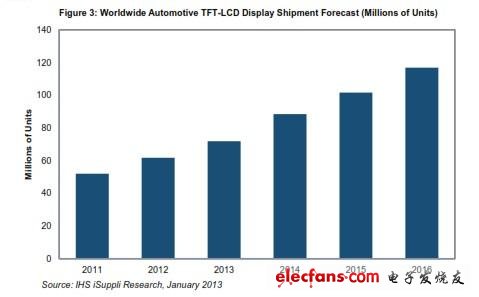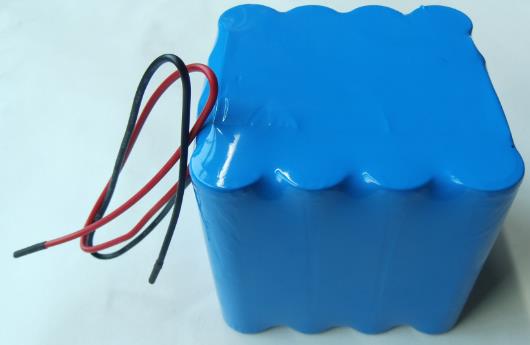According to IHS iSuppli's mobile and emerging displays and technical services, as more and more are used in mid-range and economy cars, 2012-2016 on-board car display shipments will nearly double. Part of the reason is that the United States requires cars to use rear-view cameras.
It is estimated that the shipments of automotive displays will reach 116.8 million in 2016, a 89% increase from the 61.7 million in 2012. During the above forecast period, the annual shipment growth rate will be double digits, ranging from 14.9% to 23.1%. In 2015, shipments will exceed the 100 million mark, as shown in the figure. These products are full-color TFT-LCD displays.

Figure: Global automotive TFT-LCD display shipment forecast (in millions)
In 2012, about 37% of car display shipments came from the 7.x-inch field, accounting for the majority. Most car manufacturers such as BMW, Volkswagen, Toyota, Ford and General Motors choose this size for their car navigation and infotainment systems. Platforms using a 7-inch center console display include General Motors IntelliLink, Nissan navigation system, and Toyota Premium HDD navigation. The 7-inch touch monitor may also be the main size used by the emerging dual-monitor console trend. Many concept cars such as In? NiTI LE and Acura RLX use dual displays in the center console.
Due to steady growth in demand, it is expected that 7.x inches will maintain a leading position in the field of automotive displays in the next four years.
Last year ’s second largest car display size was 3.x inches, with a 19% market share. 3.x-inch displays are usually used in two ways: either as a multi-display panel on the mid-range car dashboard, or as a simple infotainment display for many economical cars. Compared with other car categories, the center console display has a lower share of economy cars, but the overall market size of economy cars is huge, which helps 3.x-inch displays to achieve good performance.
7.x and 3.x inches together account for 56% of the automotive display market, and the remaining share is occupied by 6.x, 4.x and 8.x inch displays.
The United States requires that all cars be equipped with rear-view cameras by 2014. This will be an important factor driving the growth of automotive displays. It is expected that the United States will account for 21% of global automotive display sales by then. This instruction to install a rear-view camera is to help expand the driver's field of vision, thereby improving car safety. The directive will mainly affect economic vehicles. The average sales price of the 3.x-inch display is low, and it is expected to be the first choice for economy cars, while the larger size displays from 6.x to 8.x are more likely to appear in mid-range cars.
Automotive displays provide a sustainable business opportunity for display manufacturers
Compared with other display applications, the automotive display market is highly customized and requires different display specifications to match the brand value of the car. Design and production usually have a long life cycle, and automotive displays must support a five-year automotive production period, including support guarantees and SKUs for additional years. Display suppliers are not satisfied with selling displays used in consumer electronics products such as TVs, mobile phones, tablet computers, and digital cameras. Currently, there is increased interest in entering the automotive market because automotive replaceable standard parts have a supply chain life of up to 10 years.
Japanese manufacturers such as Sharp and JDI were major auto display suppliers in 2012. The car display products of these two companies provide a high degree of customization, and can also meet the various technical requirements of car manufacturers and car display system integrators. Overall, because Japanese manufacturers use a large amount of third- and fourth-generation factories' production capacity for the production of automotive displays, they have succeeded in completing large orders.
The rapid growth of this market is also attracting other suppliers to join. Taiwan suppliers such as AUO and CMI, as well as Korean display suppliers such as LG Display, are allocating factory capacity to produce more automotive displays.
IHS iSuppli believes that competition in the automotive display market is expected to increase in the next five years, and suppliers must keep up with changes in market dynamics and gain insight into key trends so that they can seize emerging business opportunities.
Vinita Jakhanwal is the director of small and medium displays at HIS.
Low temperature lithium battery refers to the working temperature under - 20 ℃,to meet different environment and temperature. YFJ company has designed a lot of this kind of Low Temperature Battery with our own advantages.
1.Dual IC chips, that can anti-shortcircuit, anti-overcharger, anti-overcurrent, anti-overload
2.Widely using temperature range, lower temperature Lithium Battery can be operated in -50°C~+60°C
3.Long
cycle life, more than 500 charge/discharge cycles (0.2C)( 80% capacity remained
). more than 800 times(0.1C charge/discharge
4.The Battery Pack has a high cycle life, which conforms
to the values of low carbon, energy saving and environmental protection
Low Temperature Lithium Battery
Items specification
Charge voltage: 16.8V
Nominal voltage: 14.8V (4S4P)
Initial impedance: 200mΩ
Nominal capacity: 10Ah
Minimum capacity: 9.8Ah
Low-temperature capacity : ≥7.0Ah When the battery is standard charged, it shall be put into chamber at ( -40±2 )℃ for 8-16hrs,then discharged at 0.2C(2A) constant current to10.0V.
Charge current : Standard Charging::0.2C5A (2A)
Rapid charge:1.0C5A C(10A) Max
Charging time : Standard Charging:6.5hours(Ref.)
Rapid charge: 2.5hours(Ref.)
Max.discharge current : 10A(1C5A)
Discharge cut-off voltage : 10.0V
Shelf life : 2 years
Cycle life (0.2C5A/0.2C5A) : 500 times,≧80%DOD; 500 times, ≧80%DOD
Operating temperature : Charging: 0℃~45℃ Discharging:-40℃~+60℃

Low Temperature Lithium Battery
Low Temperature Lithium Battery,Low Temperature Battery,Low Temperature Lithium Ion Battery,Low Temperature Rechargeable Battery
YFJ TECHNOLOGY (HK) CO.,LIMITED , http://www.yfjpower.com